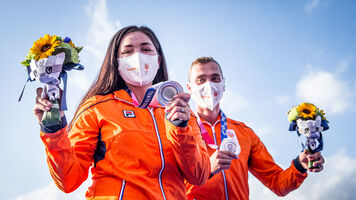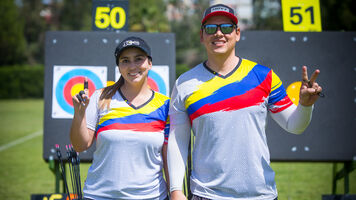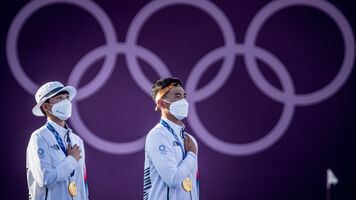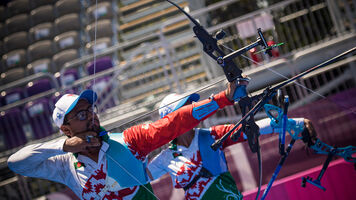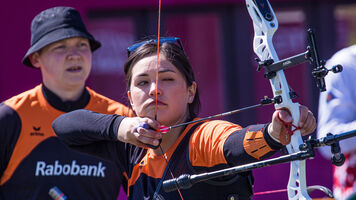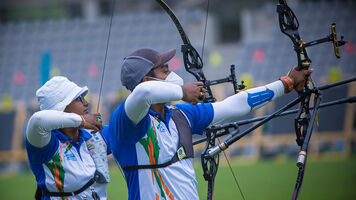Archery’s mixed team: A milestone for gender equity and inclusion

As we step into March and to recognise gender equity month, let’s reflect on the origins of archery’s mixed team event, a game-changer in breaking barriers and creating equal opportunities for both men and women.
First introduced on the Olympic stage at Tokyo 2020 and returning for Paris 2024, this innovative format emphasises teamwork, trust and inclusivity, earning global admiration.
Although archery has long been a core sport in the Games, it was defined by individual events for men and women until 1988, when separate men’s and women’s team events were introduced.
But this still left talented female archers from smaller countries unable to compete at the highest level, as they often didn’t have enough counterparts to form a fully-fledged women’s team.
The idea for the mixed team event emerged around 20 years ago, thanks to Alison Williamson. Frustrated with the lack of opportunities for female archers, especially in smaller nations, the six-time British Olympian was one of the earliest advocates for a change in the mid-2000s.
“Not only was this overtly sexist, but it also prevented some of the world’s developing countries and minnows, in archery terms, from sending female participants,” she said.
Williamson advocated for a format where one male and one female archer could compete together, a change that would level the playing field and create more opportunities for women in archery.

By introducing the mixed team format, World Archery created a ground-breaking opportunity for female athletes, ensuring they were no longer left behind due to technicalities related to team composition.
Tom Dielen, secretary general of World Archery, highlighted the event’s importance in changing the sport’s culture.
“It shows that in our sport, there’s not much difference between men and women. It’s a quick, entertaining event that fits well with the times,” he said.
The commitment to inclusivity is reflected in the event’s fast-paced nature and dynamic partnerships, where success depends on trust and synchronisation between the partners, rather than individual prowess alone.
“The mixed doubles event is the quickest competition in archery. It requires total trust between the archers. There’s no time to overthink your shot – you have to rely on your partner,” Dielen added.
This unique dynamic adds a new layer of excitement and strategy, ensuring the event’s continued success and innovation in the sport, making it a thrilling watch for both competitors and fans alike.
However, the journey to making the mixed team event a reality was not without its challenges.

It all began with early tests in the mid-2000s, including a hit-and-miss target system at the 2006 World Archery University Championships in Slovakia.
The concept gained further traction when Williamson teamed up with Russia’s Andrey Abramov for a mixed-nation, mixed-gender competition at the Archery World Cup stage in Dover in 2007, before the first televised mixed team match aired in 2008 at the Archery World Cup Final in Lausanne, sparking excitement.
Chris Marsh, former World Archery events director, vividly remembered the experience.
“The target looked tiny, and the hit-and-miss system felt strange, but I loved the concept,” Marsh recalled. “Partnering with one of the best female archers, Park Sung-Hyun, was a dream.”
The crowd loved the fast-paced action, and the event quickly gained momentum.
Following further trials, the mixed team event officially debuted at the 2010 Archery World Cup in Porec and was included in the 2010 Youth Olympic Games in Singapore, where the event further solidified its place.
The standout moments came when Türkiye’s Begunhan Unsal and Singapore’s Abdud Dayyan Bin Mohamed Jaffar won bronze together, prompting Belgium’s Dr Jacques Rogge, then president of the International Olympic Committee, to quip:
“An event where a team composed of the host country and the country of the World Archery president get a medal together, this had to be a Belgian invention!”

The Tokyo 2020 Games marked a historic moment for archery when the first-ever Olympic mixed team gold medal was awarded. South Korea’s An San and Kim Je Deok made history, winning the inaugural event, hitting a one-in-a-million Robin Hood on the way.
Their victory represented the strength of collaboration and equality, and their moment on the podium highlighted the importance of breaking down barriers in sport.
“I remember standing on the podium with An San and hearing our national anthem – it was surreal,” Kim Je Deok reflected. “We worked so hard to get there, and to make history together was something I’ll never forget.”
Following its success in Tokyo, the mixed team event returned to the Olympic stage at Paris 2024, and it continues to be a focal point for World Archery’s push toward inclusivity and innovation.
“I love mixed team, it’s a different dynamic,” five-time Olympic medallist Brady Ellison said after winning mixed team bronze alongside Casey Kaufhold in the French capital. “Cohesion-wise, the mixed teams probably get along better than any of our other teams.”
“It’s easier to shoot, but also it’s the hardest medal to win, because it’s your best man and your best woman, and every country has a good man and a good woman,” Ellison added.

The mixed team archery event has proven to be a valuable asset not just for gender equity, but also for the sport’s visibility and appeal.
The format is exciting to watch, fast-paced, and focuses on teamwork and precision, making it appealing to audiences worldwide.
By giving both male and female athletes the chance to collaborate and succeed together, it also paves the way for more countries, including smaller nations, to field competitive teams and share in the excitement to compete on the world – and Olympic – stage.
The success of the mixed team event at Tokyo 2020 and its return in Paris 2024 proves that it’s not just a passing trend, but an important part of archery’s future.
It sets a new standard for inclusivity, showing that sports can thrive while promoting equal opportunities for all.








